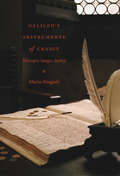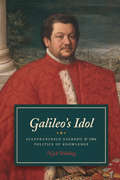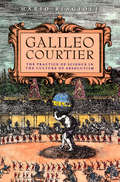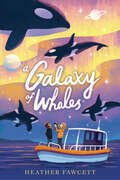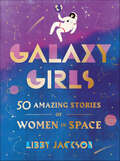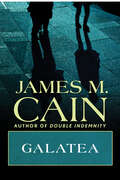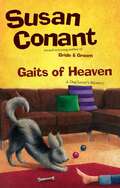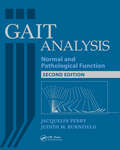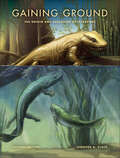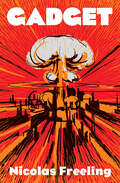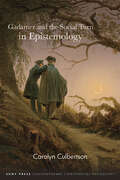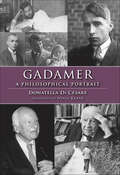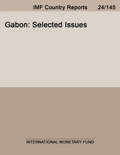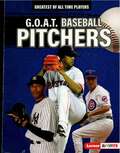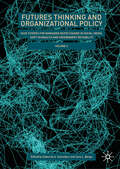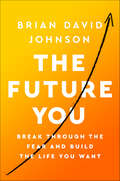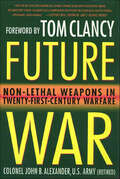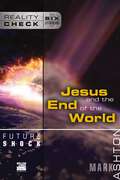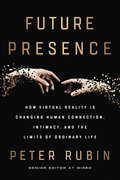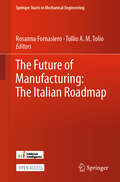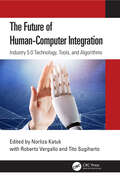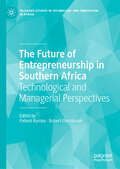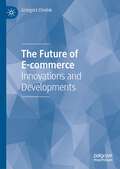- Table View
- List View
Galileo's Instruments of Credit: Telescopes, Images, Secrecy
by Mario BiagioliIn six short years, Galileo Galilei went from being a somewhat obscure mathematics professor running a student boarding house in Padua to a star in the court of Florence to the recipient of dangerous attention from the Inquisition for his support of Copernicanism. In that brief period, Galileo made a series of astronomical discoveries that reshaped the debate over the physical nature of the heavens: he deeply modified the practices and status of astronomy with the introduction of the telescope and pictorial evidence, proposed a radical reconfiguration of the relationship between theology and astronomy, and transformed himself from university mathematician into court philosopher.Galileo's Instruments of Credit proposes radical new interpretations of several key episodes of Galileo's career, including his early telescopic discoveries of 1610, the dispute over sunspots, and the conflict with the Holy Office over the relationship between Copernicanism and Scripture. Galileo's tactics during this time shifted as rapidly as his circumstances, argues Mario Biagioli, and the pace of these changes forced him to respond swiftly to the opportunities and risks posed by unforeseen inventions, further discoveries, and the interventions of his opponents. Focusing on the aspects of Galileo's scientific life that extend beyond the framework of court culture and patronage, Biagioli offers a revisionist account of the different systems of exchanges, communication, and credibility at work in various phases of Galileo's career. Galileo's Instruments of Credit will find grateful readers among scholars of science studies, historical epistemology, visual studies, Galilean science, and late Renaissance astronomy.
Galileo's Idol: Gianfrancesco Sagredo & the Politics of Knowledge
by Nick WildingGalileo’s Idol offers a vivid depiction of Galileo’s friend, student, and patron, Gianfrancesco Sagredo (1571–1620). Sagredo’s life, which has never before been studied in depth, brings to light the inextricable relationship between the production, distribution, and reception of political information and scientific knowledge. Nick Wilding uses as wide a variety of sources as possible—paintings, ornamental woodcuts, epistolary hoaxes, intercepted letters, murder case files, and others—to challenge the picture of early modern science as pious, serious, and ecumenical. Through his analysis of the figure of Sagredo, Wilding offers a fresh perspective on Galileo as well as new questions and techniques for the study of science. The result is a book that turns our attention from actors as individuals to shifting collective subjects, often operating under false identities; from a world made of sturdy print to one of frail instruments and mistranscribed manuscripts; from a complacent Europe to an emerging system of complex geopolitics and globalizing information systems; and from an epistemology based on the stolid problem of eternal truths to one generated through and in the service of playful, politically engaged, and cunning schemes.
Galileo Courtier: The Practice of Science in the Culture of Absolutism (Science and Its Conceptual Foundations series)
by Mario BiagioliInformed by currents in sociology, cultural anthropology, and literary theory, Galileo, Courtier is neither a biography nor a conventional history of science. In the court of the Medicis and the Vatican, Galileo fashioned both his career and his science to the demands of patronage and its complex systems of wealth, power, and prestige. Biagioli argues that Galileo's courtly role was integral to his science—the questions he chose to examine, his methods, even his conclusions.Galileo, Courtier is a fascinating cultural and social history of science highlighting the workings of power, patronage, and credibility in the development of science.
A Galaxy of Whales
by Heather FawcettA perfect summer read about whale watching and friendship both lost and found, from the author of Emily Wilde&’s Encyclopaedia of Faeries and The Islands of ElsewhereWhen Fern hears about a photo contest with a big cash award, she decides she&’ll enter and win! After all, photography is her passion (and was an interest she shared with her dad, who has recently died). She knows she can take a prize-worthy photo of a whale during one of the whale-watching tours her mom runs.But her neighbor (and nemesis), Jasper, is also planning to enter the contest. It&’s another frustration for Fern while she&’s already coping with the worry that her best friend, Ivy, might not want to spend time with her anymore. She&’s hoping to use the prize money to buy something that will attract Ivy&’s interest.This summer story has everything: the trials and pleasures of friendship, a rousing feud and a touch of adventure, a beautiful exploration of healing after grief, a very moving finale, and a whole lot of whale-watching fascination.
Galaxy Girls: 50 Amazing Stories of Women in Space
by Libby JacksonFilled with beautiful full-color illustrations, a groundbreaking compendium honoring the amazing true stories of fifty inspirational women who helped fuel some of the greatest achievements in space exploration from the nineteenth century to today—including Hidden Figure’s Mary Jackson and Katherine Johnson as well as former NASA Chief Astronaut Peggy Whitson, the record-holding American biochemistry researcher who has spent the most cumulative time in space.When Neil Armstrong stepped off the ladder of the lunar module, Eagle, he famously spoke of “one small step for man.” But Armstrong would not have reached the moon without the help of women. Today, females across the earth and above it—astronauts and mathematicians, engineers and physicists, test pilots and aerospace psychophysiologists—are pushing the boundaries of human knowledge, helping us to understand the universe and our place in it. Galaxy Girls celebrates more than four dozen extraordinary women from around the globe whose contributions have been fundamental to the story of humankind’s quest to reach the stars.From Ada Lovelace in the nineteenth century to the “colored computers” behind the Apollo missions, from the astronauts breaking records on the International Space Station to the scientific pioneers blazing the way to Mars, Galaxy Girls goes boldly where few books have gone before, celebrating this band of heroic sisters and their remarkable and often little known scientific achievements. Written by Libby Jackson, a leading British expert in human space flight, and illustrated with striking artwork from the students of London College of Communication, Galaxy Girls will fire the imaginations of trailblazers of all ages.
Galatea
by James M. CainA down-on-his-luck boxing trainer finds a woman worth fighting for in this “assured” novel by an MWA Grand Master Award winner (Kirkus Reviews).It took some doing, but Duke Webster is out of prison. Val Valenty arranged the parole, and now the onetime prizefighter and boxing coach is his puppet, breaking his back on Valenty’s farm in exchange for a pittance. But Valenty is about to find out that boxing men never take orders without a scrap. The trouble begins when Webster meets Valenty’s wife. A barrel-shaped woman whose extreme weight makes her old before her time, Holly stays fat on Valenty’s cooking—meat, potatoes, and endless gravy. Webster puts her on a diet, slimming her down the way he would train an over-the-hill pro in search of a comeback. But as her waistline shrinks and her beauty emerges, Valenty gets jealous—putting them on course for a bloody confrontation where only the hungry will survive.This gritty, surprising tale comes from the acclaimed author of Double Indemnity and Mildred Pierce—a writer with “an empathy for losers and society’s lost souls” (Quad-City Times).Praise for James M. Cain’s fiction“Cain is one novelist who has something to teach just about any writer, and delight just about any reader.” —Anne Rice, #1 New York Times–bestselling author of Interview with a Vampire“Entertaining and cleverly plotted.” —The New York Times
Galahad and I Thought of Daisy
by Edmund WilsonFrom one of the leading literary critics of his generation comes the first of Edmund Wilson's three novels, I thought of Daisy, published together with his short story "Galahad." Set in Greenwich Village in the 1920s, Edmund Wilson’s I Thought of Daisy tells the coming of age story of a young man living a bohemian life, and of his heartfelt relationship with a chorus girl he meets at a party. Fictional sketches drawn from real-life literary figures are scattered throughout, including John Dos Passos and Wilson's lover, Edna St. Vincent Millay.Also included in this volume is Wilson's short story "Galahad," about the sexual awakening of a young boy at prep school."What needs to be [said] is how good, if ungainly, Daisy is, how charmingly and intelligently she tells of the speakeasy days of a Greenwich Village as red and cozy as a valentine, of lamplit islands where love and ambition and drunkenness bloomed all at once. The fiction writer in Wilson was real, and his displacement is a real loss." - John Updike
Gaits of Heaven (Dog Lover's #17)
by Susan ConantPraised for its "eccentric and quirky characters (Publishers Weekly) Susan Conant's "hilarious" (Los Angeles Times) series now finds dedicated dog trainer Holly Winter following the tracks of an odd breed of pup to an even stranger breed of human... Poor Dolfo. It wasn't the golden Aussie huskapoo's fault that he wasn't housebroken. Blame it on his owners, Ted and Eumie, a New Age couple who couldn't bring themselves to restrain a dog's free spirit with collars, leashes, or obedience training. Leave that to Holly Winter, who's been enlisted to do it for them. Now, she's just one of a pack of psychiatrists, psychologists, pharmacologists, and alternative healers who medicate the dysfunctional pair, soothe their troubled children, and placate their bitter ex-spouses. Unfortunately, Eumie's "trauma history" gets the best of her when she succumbs to an accidental overdose of mixed meds. Her daughter, Caprice, a human stray who knows the dirty little secrets of both sides of the family, is convinced it was murder. So is Holly. But who hated—or feared— Eumie enough to have her put down? It's up to Holly to find a killer, sort out the motives and mysteries of the shady brood, and get back to giving Dolfo the attention he deserves...
Gait Analysis: Normal and Pathological Function
by Jacquelin Perry Judith BurnfieldThe extensive and ground-breaking work of Dr. Jacquelin Perry is encompassed and detailed in the world renowned text, Gait Analysis: Normal and Pathological Function. The medical, healthcare, and rehabilitation professions key text for over 18 years on gait….Now available in a much anticipated New Second EditionDr. Jacquelin Perry is joined by Dr. Judith Burnfield to present today's latest research findings on human gait. Gait Analysis, Second Edition has been updated and expanded to focus on current research, more sophisticated methods, and the latest equipment available to analyze gait.What is New:• A new chapter covering running• Synergy of motion between the two limbs• A new chapter covering pediatrics • A new chapter covering stair negotiation• New and updated clinical examples• A section on power inside each chapter covering normal gait• New methods and equipment to analyze gaitThis Second Edition to Gait Analysis offers a re-organization of the chapters and presentation of material in a more user-friendly, yet comprehensive format. Essential information is provided describing gait functions, and clinical examples to identify and interpret gait deviations. Learning is further reinforced with images and photographs.Features:• Six sections cover the fundamentals, normal gait, pathological gait, clinical considerations, advanced locomotor functions, and gait analysis systems• Clinical significance of the most common pathological gait patterns• Over 470 illustrations and photographs, as well as 40 tables• Patient examples to illustrate elements of normal and pathological gaitTens of thousands of orthopedic, orthotic and prosthetic, physical therapy, and other rehabilitation professionals have kept a copy of Gait Analysis by their side for over 18 years…join the thousands more who will bring the Second Edition into their clinics, classrooms, and personal collections.
Gaining Ground: The Origin and Evolution of Tetrapods (Life of the Past)
by Jennifer A. ClackAround 370 million years ago, a distant relative of a modern lungfish began a most extraordinary adventure—emerging from the water and laying claim to the land. Over the next 70 million years, this tentative beachhead had developed into a worldwide colonization by ever-increasing varieties of four-limbed creatures known as tetrapods, the ancestors of all vertebrate life on land. This new edition of Jennifer A. Clack's groundbreaking book tells the complex story of their emergence and evolution. Beginning with their closest relatives, the lobe-fin fishes such as lungfishes and coelacanths, Clack defines what a tetrapod is, describes their anatomy, and explains how they are related to other vertebrates. She looks at the Devonian environment in which they evolved, describes the known and newly discovered species, and explores the order and timing of anatomical changes that occurred during the fish-to-tetrapod transition.
Gadget
by Nicolas FreelingFrom an Edgar award winner, this thriller about a physicist forced to make an A-bomb is &“a splendid account of the excesses of science and bureaucracy&” (The New York Times). An American physicist working in Hamburg, Jim Hawkins is on his way home from his job at a German nuclear institute when he is rammed off the road and abducted by terrorists. Drugged and taken to a secret location, he wakes to find himself being held hostage alongside his terrified wife and daughters. With nothing else to do but comply with the terrorists&’ demands, Jim begins to build a weapon powerful enough to destroy the world. The target: a conference in Lake Geneva, where heads of state are meeting, even as news of his abduction has reached the ears of the American president, only to be dismissed as rumor. Will anyone be able to convince the world leaders of the threat in time? &“Freeling moves from straight suspense to a science thriller and keeps his kinkiness intact. . . . Brilliant.&” —Kirkus Reviews, starred review
Gadamer and the Social Turn in Epistemology (SUNY series in Contemporary Continental Philosophy)
by Carolyn CulbertsonWhile some take Gadamer's Truth and Method to be a departure from epistemological questions and concerns, author Carolyn Culbertson reads Gadamer's work as offering a valuable reflection on the nature of understanding—one that is deeply resonant with the recent social turn in epistemology. Like social epistemologists, Gadamer worries about the epistemic irresponsibility that we encourage when we treat an attitude of objectivity, wherein the inquirer lacks any awareness of their social and historical situation, as an epistemic ideal. Like social epistemologists too, Gadamer argues that understanding that one is socially and historically situated does not mean believing that one is fated to simply repeat traditional ideas without critique or modification—a concern frequently raised in response to critiques of Enlightenment epistemology. By developing such parallels, Gadamer and the Social Turn in Epistemology offers seasoned readers of Gadamer a new context in which to appreciate his discussion of understanding in Truth and Method and readers unfamiliar with Gadamer a productive point of access into his major work.
Gadamer: A Philosophical Portrait (Studies in Continental Thought)
by Donatella Di CesareHans-Georg Gadamer (1900-2002), one of the towering figures of contemporary Continental philosophy, is best known for Truth and Method, where he elaborated the concept of "philosophical hermeneutics," a programmatic way to get to what we do when we engage in interpretation. Donatella Di Cesare highlights the central place of Greek philosophy, particularly Plato, in Gadamer's work, brings out differences between his thought and that of Heidegger, and connects him with discussions and debates in pragmatism. This is a sensitive and thoroughly readable philosophical portrait of one of the 20th century's most powerful thinkers.
Gabon: Selected Issues (Imf Staff Country Reports)
by International Monetary Fund. African Dept.A report from the International Monetary Fund.
G.O.A.T. Baseball Pitchers (Greatest Of All Time Players (lerner (tm) Sports) Ser.)
by Alexander Lowe“Pitchers can influence games more than any other player on the field. Read about the stats and championship moments of baseball's greatest pitchers. Then use what you learned to create your own top-10 list!”
Futures Thinking and Organizational Policy, Volume 2: Case Studies for Managing Rapid Change in Social Media, Shift in Wealth and Government Instability
by Zane L. Berge Deborah A. SchreiberThe case studies in this Volume 2 book support the premise that organizational policies are what ensure institutionalization and sustainability of futures thinking in corporations, non-profits, and educational institutions. Futures thinking here reflects a systems approach utilized by organizational leaders to observe and interpret signals of change or disruption, identify trigger points of impact, employ foresight methodologies to build scenarios of the future and plan action, and then ultimately translate/actualize the most viable scenarios into successful business outcomes. What is new in the field of futures thinking today is not the general source of change (i.e., technology, globalization, and workforce well-being), but the tumultuous level of disruption occurring due to three phenomena—explosive use of social media, shift in great wealth, and government instability. Scholars and practitioners alike will find the case studies in this book provide nuanced insights into such disruptions, as well as discussion of best practices to ensure successful business solutions.
The Future You: Break through the Fear and Build the Life You Want
by Brian David JohnsonYOUR FUTURE STARTS NOWBy the time you reach the end of the book, I promise you will understand your Future You better than ever...you will be able to see yourself in the future you want and know the steps needed to get there.Brian David Johnson has spent a quarter century helping governments, schools, corporations, and small businesses shape the future—now, he wants to help you. In The Future You, Johnson distills his work as an applied futurist and gives readers the practical tools to craft the future they’ve always wanted. Offering a unique combination of practical guidance, interactive workbooks, and compelling real-life stories, The Future You empowers readers to break through the fear of uncertainty. Whether you want to find your new passion, switch your career, or make a personal change, fear holds so many of us captive and prevents us from taking the steps necessary to start now. You no longer have to just dream about a better future, you can turn those plans, those ideas, and those hopes into reality.
The Future Was Color: A Novel
by Patrick NathanA dazzling novel about the inextricable link between the personal and the political set against the decadence of Hollywood and postwar Los AngelesAs a Hungarian immigrant working as a studio hack writing monster movies in 1950s Hollywood, George Curtis must navigate the McCarthy-era studio system filled with possible communists and spies, the life of closeted men along Sunset Boulevard, and the inability of the era to cleave love from persecution and guilt. But when Madeline, a famous actress, offers George a writing residency at her estate in Malibu to work on the political writing he cares most deeply about, his world is blown open. Soon Madeline is carrying George like an ornament into a class of postwar L.A. society ordinarily hidden from men like him.What this lifestyle hides behind, aside from the monsters on the screen, are the monsters dwelling closer to home: this bacchanalia covers a gnawing hole shelled wide by the horror of the war they thought they&’d left behind and the glimpse of an atomic future. It&’s here that George understands he can never escape his past as György, the queer Jew who fled Budapest before the war and landed in New York, all alone, a decade prior.Spanning from sun-drenched Los Angeles to the hidden corners of working-class New York to a virtuosic climax in the Las Vegas desert, The Future Was Color is an immaculately written exploration of postwar American decadence, reinventing the self through art, and the psychosis that lingers in a world that&’s seen the bomb.
Future War: Non-Lethal Weapons in Twenty-First-Century Warfare
by John B. AlexanderThe nature of warfare has changed! Like it or not, terrorism has established a firm foothold worldwide. Economics and environmental issues are inextricably entwined on a global basis and tied directly to national regional security. Although traditional threats remain, new, shadowy, and mercurial adversaries are emerging, and identifying and locating them is difficult. Future War, based on the hard-learned lessons of Bosnia, Haiti, Somalia, Panama, and many other trouble spots, provides part of the solution.Non-lethal weapons are a pragmatic application of force, not a peace movement. Ranging from old rubber bullets and tear gas to exotic advanced systems that can paralyze a country, they are essential for the preservation of peace and stability. Future War explains exactly how non-lethal electromagnetic and pulsed-power weapons, the laser and tazer, chemical systems, computer viruses, ultrasound and infrasound, and even biological entities will be used to stop enemies. These are the weapons of the future.
Future Shock: Jesus and the End of the World (Reality Check)
by Mark AshtonThe Reality Check series makes just one assumption: that you’re serious enough about your spiritual journey to investigate Christianity with an open mind. This isn’t about joining anyone’s religious club—it’s about being real with yourself and with the others in your group. Since no one has all the answers, there’s plenty of room for discussion. After all, if there is any truth to the Bible’s stories about Jesus, then one thing he’d welcome are questions and opinions that come from honest, earnest hearts.What do you think the future holds? Right now it looks pretty scary. And Bible prophecy hardly brightens the picture—not with its mind-boggling images of singing saints, ten-horned monsters, mystical numbers, and a lake of fire. What does it all mean? Fortunately, it does mean something. A great deal. And while the Bible paints a grim future for a world bent on worshiping its own ways, it offers great hope for those whose hearts are set on God. Future Shock includes these sessions: Will Jesus Return This Year? · The Scroll Opener · After the Gavel Falls . . . · Ultimate Evil: The Antichrist, the Beast, and 666 · Happily Ever After? · Flight TrainingFor the Group LeaderReality Check is for spiritual seekers of every persuasion. Uncompromisingly Christian in its perspective, it steers wide of pat answers and aims at honesty. This innovative and thought-provoking series will challenge you and those in your group to connect heart to heart as together you explore the interface between Jesus, the Bible, and the realities of this world in which we live.
Future Presence: How Virtual Reality Is Changing Human Connection, Intimacy, and the Limits of Ordinary Life
by Peter RubinA Wired senior editor and virtual reality expert presents a captivating, candid glimpse into the future "realities" of this emerging technology: how we will use it to form previously impossible relationships, explore new frontiers of intimacy, and how it will forever change human connection.Heralded as the most significant technological innovation since the smartphone, virtual reality is poised to transform our very notions of life and humanity. Though this tech is still in its infancy, to those on the inside, it is the future. VR will change how we work, how we experience entertainment, how we feel pleasure and other emotions, how we see ourselves, and most importantly, how we relate to each other in the real world. And we will never be the same.Peter Rubin, senior culture editor for Wired and the industry’s go-to authority on the subject, calls it an "intimacy engine." While once we needed another person to feel the sensations of closeness, trust, vulnerability, confidence, and titillation, VR will give us the ability to induce these sensations by ourselves for the first time in human history. This metamorphosis, Rubin argues, is going to have a powerful impact on relationships that will ripple throughout our society and our individual lives.A journey into this uncertain future and a glimpse at the cultural implications and promises of a new reality, Future Presence explores a host of complex questions about what makes us human, what connects us, and what is real. Offering a glimpse into the mind-blowing things happening in universities, labs, and tech companies around the world, Rubin leads readers on an entertaining tour of the weirdest, wildest corners of this fascinating new universe. Describing this book as "half travelogue and half crystal ball", Rubin will:Introduce readers to the creators and consumers of VR technologyShow readers what an experience is like inside the current VR devicesExplain how this technology will upend everything we know about human connection in the futureAt once the incredible, inevitable story of virtual reality’s rise and a look towards the future of our fantasies, Future Presence is a deeply personal examination of what connects us, and an analysis of what relationships, empathy, and sex could look like—sooner than we think.
The Future of Manufacturing: The Italian Roadmap (Springer Tracts in Mechanical Engineering)
by Rosanna Fornasiero Tullio A. M. TolioThis book is an open access publication. This book explores innovation paths for improving the positioning of the manufacturing sector in the international arena. The roadmap is the result of intense work over two years, during which companies, universities, research bodies, and associations came together to build a systemic vision for the themes of research and technological innovation with a medium to long term outlook. The work is based on a collaborative framework whereby top-down analysis of the global development trends and scenarios generating the challenges for manufacturing is integrated with a bottom-up approach that engages the Cluster's members in bringing forward their research needs. The roadmap's proposal is structured along 7 strategic action lines designed to face the challenges from the market such as personalized production, industrial sustainability, valorization of humans in factories, high efficiency, and to seize and develop the opportunities offered by enabling technologies such as innovative production processes, evolving and reconfigurable processes, cybersecurity, AI, and digital platforms.
The Future of Human-Computer Integration: Industry 5.0 Technology, Tools, and Algorithms
by Norliza Katuk Roberto Vergallo Tito SugihartoThe Future of Human-Computer Integration: Industry 5.0 Technology, Tools, and Algorithms provides a valuable insight into how Industry 5.0 technologies, tools, and algorithms can revolutionise industries and drive innovation.By emphasising the convergence of computer technology and human interaction, readers will learn the concepts of Industry 5.0, from the fundamentals to advanced techniques, with real-world examples and case studies in different industry sectors. The authors equip readers with the knowledge to mitigate risks to ensure success in this complex human and computer synchronisation in the era of Industry 5.0. This collection of writings by experts in their respective fields invites readers to journey through the transition from Industry 4.0 to Industry 5.0. Practical insights are offered alongside cutting-edge applications, such as blockchain, the Internet of Things (IoT), QR code, and augmented reality (AR), as well as the consideration of privacy, trust, and authentication through digital signatures. Such technologies and applications hold much promise to revolutionise industries and drive innovation.Topics in this book include the role of AI in human-computer interaction, efficient asset management using blockchain, computational thinking in program development, synergy of 5G and IoT in healthcare services, advances in increasing data capacity of QR codes, and personalised user experience with augmented reality. The authors also consider the challenges, risks, and concerns of such technologies and their applications in Industry 5.0. This book comprehensively explores Industry 5.0 from a computer science perspective as it delves into the technology aspects and tools for Industry 5.0. It offers readers a detailed understanding of how computer science intersects with Industry 5.0, how to humanise it, and its application to industry.This book has been written for technology professionals and practitioners, especially ones in healthcare, smart systems, and the oil and gas sectors. It will serve as a useful reference for students studying such advanced courses as digital technology, digital transformation, emergent technologies, and innovation through new technologies.
The Future of Entrepreneurship in Southern Africa: Technological and Managerial Perspectives (Palgrave Studies in Technology and Innovation in Africa)
by Robert Ebo Hinson Patient RambeThis edited collection examines the impact of new technologies and new managerial and policy perspectives on entrepreneurial development in Southern Africa, paying particular attention to small and medium sized enterprises, which contribute significantly to GDP and employment, but often find it difficult to survive beyond the first five years. Chapters are divided in two parts, the first covering technological perspectives and the second managerial perspectives. Africa’s cultural and geographic diversity is taken into account, with authors from Ghana, Lesotho, South Africa and Zimbabwe providing regional case studies and the editors synthesising these discussions in a concluding chapter that touches on sustainability and development to working lives and livelihoods across the region. Exploring critical issues of entrepreneurial human capital development, innovation, technology, legislative frameworks and marketing strategies, this book will be of great interest to researchers, students and policymakers.
The Future of E-commerce: Innovations and Developments
by Grzegorz ChodakThe e-commerce industry is growing year by year, with the COVID-19 pandemic having greatly accelerated this process. In response to the massive growth, this book analyses future trends in e-commerce, focusing on its importance in some parts of the economy as well key innovations, which include future logistics solutions such as automated delivery robots. The most extensive part of the book is dedicated to exploring virtual reality in e-commerce, where the author presents research on the usage of VR goggles in online stores and discusses the potential advantages and threats. Also covering key topics such as the future of payment methods, AR as an e-commerce enhancement and the direction of its development, as well as AI methods (such as ChatGPT to generate content in an online shop), this book is a key resource for anyone studying e-business.
